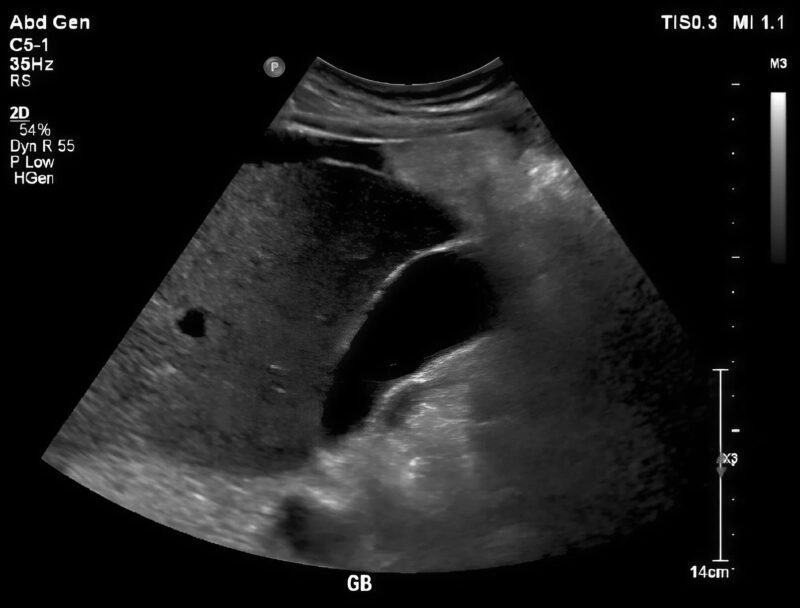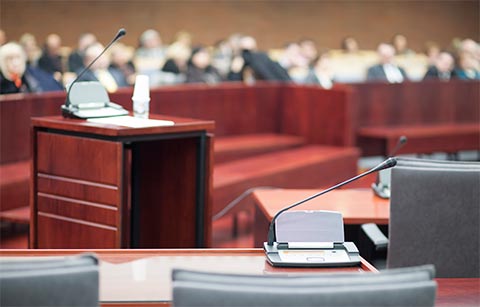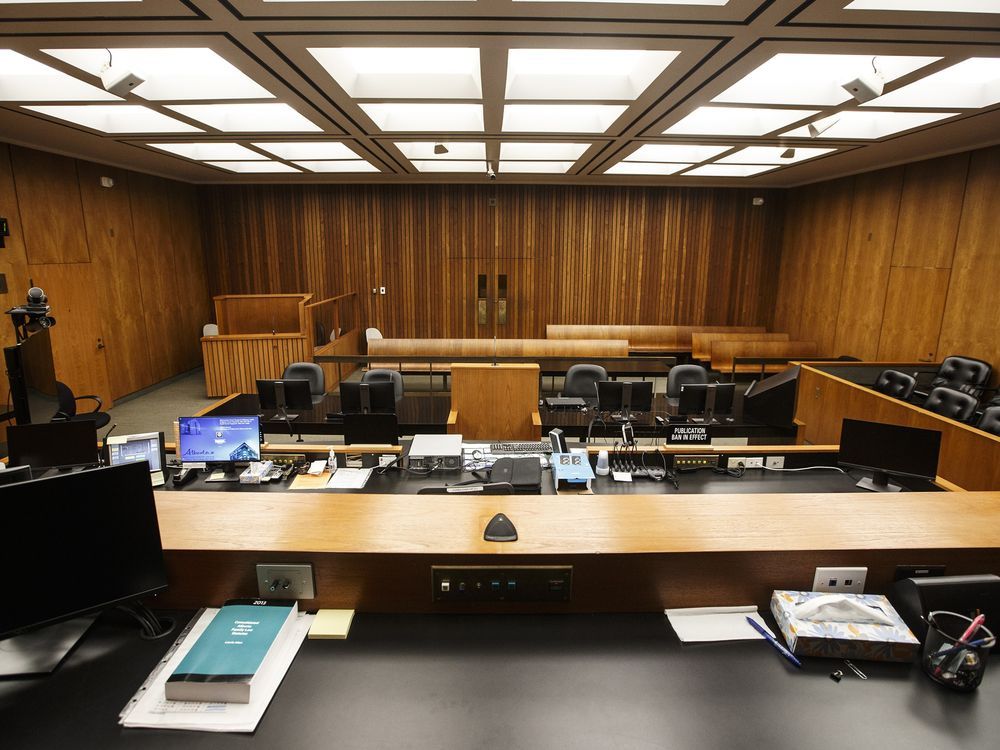
As the trial date loomed closer, Clara found herself oscillating between despair and determination. The legal intern, Sasha, was a bright young woman who had been moved by Clara’s plight and volunteered to help her despite having little experience. Together, they pored over every detail that might exonerate Clara, hoping to find an overlooked clue that would prove her innocence.
In the ornate courtroom, the trial began with an air of inevitability, as if Clara’s guilt had already been decided. The Hamilton family’s lawyer was a seasoned professional, known for his ruthless efficiency. He painted Clara as a desperate woman, driven by poverty to commit theft against the family that had taken her in. Clara sat silently, her heart sinking at the narrative being constructed around her.
The turning point came when young Idan managed to slip away from his nanny and burst into the courtroom. His presence caused a stir; the judge, initially irritated by the interruption, allowed him to speak. The boy’s innocence and determination were palpable as he stood before the court, clutching a small, crumpled piece of paper.
“Clara didn’t do it!” Idan exclaimed, his voice trembling but clear. “I saw Grandma Margaret go into Dad’s study with the jewel!”
Gasps echoed through the room as Margaret’s face paled. Idan continued, “I was playing hide and seek, and I saw her. She hid it in the old book in the library!” His revelation was met with a cacophony of murmurs from the audience, and the judge called for order.
Margaret, visibly shaken, tried to dismiss Idan’s testimony as the imagination of a child. However, the judge ordered a recess for the police to investigate the boy’s claim. Within hours, they returned with the missing jewel, exactly where Idan had described.
The atmosphere in the courtroom shifted dramatically. The Hamilton’s lawyer, who had been so confident moments earlier, now found himself struggling to manage the unexpected turn of events. Margaret’s deceit was laid bare, and Adam, realizing the grave injustice done to Clara, was visibly remorseful.
The judge, acknowledging the new evidence, pronounced Clara not guilty. Waves of relief crashed over her, tears of gratitude streaming down her face. Sasha, the intern, squeezed her hand, and Idan ran to her side, embracing her tightly.
Outside the courtroom, the press swarmed, eager to capture the story of the maid who had been vindicated by the courage of a child. Clara, still overwhelmed, made a brief statement. “I am grateful to those who believed in me when I had lost faith in myself. This experience has taught me that truth and justice can prevail, even against the most daunting odds.”
Adam approached Clara, apologizing profusely. He offered her reinstatement, but Clara declined. She had decided to start anew, away from the shadows of mistrust. Margaret, disgraced, retreated from public view, and Adam vowed to be a better father and employer.
With the trial behind her, Clara focused on rebuilding her life. She found strength in Idan’s unwavering belief in her and in the small but significant victories she had achieved. As she moved forward, Clara carried with her the lessons of resilience and the knowledge that even the humblest voice could speak truth to power.
It was supposed to be a happy day — my son’s birthday. I had brought a small gift with me and drove over to his house. But as I approached, I saw something that turned my whole world upside down.

On the porch, right by the door, stood my grandson. A little boy of only five years old, born from my late daughter-in-law. After her death, my son had remarried, and life was supposed to be happy again.
Instead, I saw a scene that pierced my heart: the child, wearing only a thin jacket, was shivering from the cold, pressing his tiny hands against his chest.
I rushed over to him immediately:
— “What are you doing out here? It’s freezing cold!”
He lifted his tearful eyes to me and whispered through chattering teeth:
— “Grandpa… I’m not allowed inside the house.”
Those words hit me like a thunderbolt. Through the brightly lit windows I could hear laughter, see the festive table, see the adults enjoying themselves and raising their glasses. But my grandson, that little boy, had been left to freeze outside.
— “How long have you been out here?” I asked, my voice trembling.
— “S… since this morning,” he replied, lowering his eyes.
I couldn’t believe my ears. Four and a half hours. My grandson had spent all that time out in the cold, hungry, with no water, no care, no warmth — just because his stepmother had decided to punish him.

He had forgotten to check the meat in the oven, and the dinner was ruined. For that small mistake, a five-year-old child had been thrown out of the house like a dog.
I didn’t hesitate any longer. I stormed into the house without knocking.
— “Dad?” My son turned pale when he saw me. “What are you doing here?”
My eyes swept over the decorated table, the dishes, the candles, the glasses of wine. And I roared so loudly that everyone froze:
— “While you sit here celebrating, your son is freezing outside!”
My son frowned, trying to appear calm:
— “This is just a family matter. He’s being punished.”
— “A family matter?” I stepped closer. “You left a five-year-old child in the cold, without food or water, and you dare tell me not to interfere? Who do you think you are?”
— “Dad, don’t ruin our party. It’s my birthday.”
— “What party?” My voice was full of contempt. “What party, when your son is trembling from the cold right outside the door?”

My son raised his voice, and his wife immediately stood by his side:
— “He’s my child, and I have the right to raise him as I see fit!”
My patience snapped. I looked him straight in the eyes and said one sentence that left him shocked
— “I’m taking my grandson with me, and you are no longer my son.”
Silence fell over the room. My son opened his mouth, wanted to say something, but the words stuck. Then he began shouting about my rights, saying I had no authority to make such decisions. But his voice was drowned out by my grandson’s sobs.
The boy clung tightly to me and through his tears kept repeating:
— “Grandpa, I don’t want to stay with them. I’m scared… This isn’t the first time…”
And in that moment I knew: the decision was made. I held him close and led him out of that house. Behind us, my son and his wife were yelling, but I didn’t care. I knew only one thing: never again would I allow my grandson to be left to freeze and suffer.

On the porch, right by the door, stood my grandson. A little boy of only five years old, born from my late daughter-in-law. After her death, my son had remarried, and life was supposed to be happy again.
Instead, I saw a scene that pierced my heart: the child, wearing only a thin jacket, was shivering from the cold, pressing his tiny hands against his chest.
I rushed over to him immediately:
— “What are you doing out here? It’s freezing cold!”
He lifted his tearful eyes to me and whispered through chattering teeth:
— “Grandpa… I’m not allowed inside the house.”
Those words hit me like a thunderbolt. Through the brightly lit windows I could hear laughter, see the festive table, see the adults enjoying themselves and raising their glasses. But my grandson, that little boy, had been left to freeze outside.
— “How long have you been out here?” I asked, my voice trembling.
— “S… since this morning,” he replied, lowering his eyes.
I couldn’t believe my ears. Four and a half hours. My grandson had spent all that time out in the cold, hungry, with no water, no care, no warmth — just because his stepmother had decided to punish him.

He had forgotten to check the meat in the oven, and the dinner was ruined. For that small mistake, a five-year-old child had been thrown out of the house like a dog.
I didn’t hesitate any longer. I stormed into the house without knocking.
— “Dad?” My son turned pale when he saw me. “What are you doing here?”
My eyes swept over the decorated table, the dishes, the candles, the glasses of wine. And I roared so loudly that everyone froze:
— “While you sit here celebrating, your son is freezing outside!”
My son frowned, trying to appear calm:
— “This is just a family matter. He’s being punished.”
— “A family matter?” I stepped closer. “You left a five-year-old child in the cold, without food or water, and you dare tell me not to interfere? Who do you think you are?”
— “Dad, don’t ruin our party. It’s my birthday.”
— “What party?” My voice was full of contempt. “What party, when your son is trembling from the cold right outside the door?”

My son raised his voice, and his wife immediately stood by his side:
— “He’s my child, and I have the right to raise him as I see fit!”
My patience snapped. I looked him straight in the eyes and said one sentence that left him shocked
— “I’m taking my grandson with me, and you are no longer my son.”
Silence fell over the room. My son opened his mouth, wanted to say something, but the words stuck. Then he began shouting about my rights, saying I had no authority to make such decisions. But his voice was drowned out by my grandson’s sobs.
The boy clung tightly to me and through his tears kept repeating:
— “Grandpa, I don’t want to stay with them. I’m scared… This isn’t the first time…”
And in that moment I knew: the decision was made. I held him close and led him out of that house. Behind us, my son and his wife were yelling, but I didn’t care. I knew only one thing: never again would I allow my grandson to be left to freeze and suffer.

My mother-in-law secretly burned my wedding dress, saying that her son could not marry someone as poor as me. My answer astonished her 💔🔥
The day I discovered what my mother-in-law had done, my heart sank. I had been dreaming about my wedding for as long as I could remember—planning every detail, imagining walking down the aisle in my beautiful white dress, and seeing my fiancé’s eyes light up with love. But nothing could have prepared me for the betrayal I felt when I learned that she had secretly burned my wedding dress. 😢👰
She had claimed that her son, my soon-to-be husband, could not possibly marry someone “as poor as me.” Her words stung worse than the flames that had destroyed my gown. Every thread, every bead, every memory woven into that dress—gone. I felt anger, heartbreak, and disbelief all at once. 💔🔥

For a moment, I considered letting her win. Maybe I should cry, beg, or even apologize for daring to love her son despite my modest background. But then I remembered why I was marrying him. It wasn’t for his family’s approval, nor their wealth. It was for love—the kind of love that makes you stronger, braver, and unshakably determined. ❤️💪
I walked into the living room where she waited, smug and confident, thinking she had destroyed not just a dress, but my spirit. She looked at me with that condescending smirk, expecting tears or submission. Instead, I smiled—a calm, steady, almost mischievous smile. 😊
“You know,” I began softly, “I’ve always believed that a wedding dress is just fabric and lace. True beauty doesn’t burn. Love doesn’t burn. And a wedding isn’t about a dress; it’s about two hearts choosing each other.” 💖🔥
Her expression shifted from triumph to confusion. I could see her trying to process my words. She probably expected me to beg, to plead, or to storm out in fury. But I wasn’t going anywhere. I wasn’t defeated. Instead, I opened my closet and pulled out another dress—one I had bought secretly, just in case of emergencies. It wasn’t extravagant, but it was elegant and perfect for me. 👗✨

“I already prepared for this,” I continued. “And today, I am marrying your son, not because of a dress, not because of money, but because we love each other. And no one, not even you, can take that away from me.” 💍💫
Her jaw dropped. She had underestimated me, underestimated our love, and underestimated the power of confidence and courage. In that moment, I realized something important: the fire she thought would destroy me only made me stronger. It revealed my strength, my independence, and my ability to rise above petty cruelty. 🔥💪💖

When my fiancé arrived, I could see the pride in his eyes. He didn’t need the perfect dress, the approval of his mother, or a flawless ceremony. He only needed me—and I him. Together, we walked down the aisle, hand in hand, hearts full, ready to start our life. 👰🤵💞

Later, when she tried to speak to me, I only smiled politely. “Thank you for showing me that love is stronger than fear and cruelty,” I said. Her silence was enough—my answer had spoken louder than any argument. ❤️✨

That day, I learned a lesson that no wedding dress could ever teach: love, courage, and self-respect are far more valuable than fabric, beads, or approval. And sometimes, the way you respond to cruelty can astonish everyone—even those who tried to break you. 💖🔥🌟
💔 From Dreadlocks to Hope: The Shocking Rescue of a Forgotten Feline 🐱✂️
When the local shelter in Greenhaven received an anonymous tip about a «strange creature» hiding behind an abandoned house, no one expected what they would find. Officers arrived cautiously, expecting perhaps a raccoon or a large stray dog. But what they found instead… broke everyone’s heart. 💔
Lying curled in the shadow of a rusted shed was a calico cat — or what barely resembled one. Her fur was an unrecognizable mess, thick ropes of hair twisted together like vines or worse… like tentacles from another world. 🐾🕸️
Even experienced rescuers were stunned. “I’ve never seen anything like this,” said Jenn, the lead veterinary technician at the local animal clinic. “It was as if she had been carrying a heavy cloak of pain for years.” 😿
The cat’s name would become Matilda. 💛 A name chosen for its gentleness, in stark contrast to her condition. She didn’t hiss. She didn’t run. She just looked up… eyes sunken, exhausted, as if pleading without words: «Please… help me.» 😞👁️

From head-on, Matilda appeared almost normal — a sweet, elderly calico with soulful eyes. But from behind, she looked like something out of a nightmare. Her entire back and hind legs were entombed in mats that swung like dreadlocks. Some were over a foot long. If you saw her from afar, you might have mistaken her for a massive hairy spider. 🕷️😧
Jenn knew she had to act quickly. Matilda was dehydrated, malnourished, and severely restricted in movement. She couldn’t sit or lie down properly. Imagine carrying 5 pounds of tangled rope on your back — every second of every day. 😣🪢
After a quick medical check-up, Jenn gently sedated Matilda. What followed was nothing short of miraculous. Over the next two hours, Jenn and her team carefully sheared away the layers of neglect. ✂️🧼 Fur fell in chunks, revealing patches of delicate skin — sore, but healing. With each snip, Matilda seemed to breathe a little easier.
When it was done, the transformation was shocking. Beneath the matted prison was a tiny, fragile body — far smaller than anyone had imagined. And once freed, Matilda curled up into a soft blanket… and for the first time in years, she purred. 🥹💤

But that was just the beginning. Over the next few weeks, Matilda slowly regained strength. She began to walk around the clinic, exploring cautiously, tail flicking with curiosity. Staff noticed she had the gentlest demeanor — she would nuzzle against anyone who paused beside her. 🐈⬛🩷
What happened to her? Investigators later found out her owner had passed away over a year ago. Matilda had been left behind, forgotten in a house with no heat, no food, and no one to care. Somehow, she survived. But she carried every second of that suffering on her back — literally. 🕯️🏚️
Now, Matilda is living with a foster family who specializes in caring for senior cats. She has a heated bed, her own sunny window perch, and a new wardrobe of fuzzy sweaters to keep her warm. ☀️🧣🧺
Her story has touched millions online. The shelter posted her before-and-after photos — and hearts melted everywhere. 💌
Matilda’s story is more than a rescue.
It’s a reminder: sometimes, the quietest creatures carry the heaviest burdens. And with just a little love, care, and courage, even the most tangled life… can be transformed. 🙏🐾❤️
When the local shelter in Greenhaven received an anonymous tip about a «strange creature» hiding behind an abandoned house, no one expected what they would find. Officers arrived cautiously, expecting perhaps a raccoon or a large stray dog. But what they found instead… broke everyone’s heart. 💔
Lying curled in the shadow of a rusted shed was a calico cat — or what barely resembled one. Her fur was an unrecognizable mess, thick ropes of hair twisted together like vines or worse… like tentacles from another world. 🐾🕸️
Even experienced rescuers were stunned. “I’ve never seen anything like this,” said Jenn, the lead veterinary technician at the local animal clinic. “It was as if she had been carrying a heavy cloak of pain for years.” 😿
The cat’s name would become Matilda. 💛 A name chosen for its gentleness, in stark contrast to her condition. She didn’t hiss. She didn’t run. She just looked up… eyes sunken, exhausted, as if pleading without words: «Please… help me.» 😞👁️

From head-on, Matilda appeared almost normal — a sweet, elderly calico with soulful eyes. But from behind, she looked like something out of a nightmare. Her entire back and hind legs were entombed in mats that swung like dreadlocks. Some were over a foot long. If you saw her from afar, you might have mistaken her for a massive hairy spider. 🕷️😧
Jenn knew she had to act quickly. Matilda was dehydrated, malnourished, and severely restricted in movement. She couldn’t sit or lie down properly. Imagine carrying 5 pounds of tangled rope on your back — every second of every day. 😣🪢
After a quick medical check-up, Jenn gently sedated Matilda. What followed was nothing short of miraculous. Over the next two hours, Jenn and her team carefully sheared away the layers of neglect. ✂️🧼 Fur fell in chunks, revealing patches of delicate skin — sore, but healing. With each snip, Matilda seemed to breathe a little easier.
When it was done, the transformation was shocking. Beneath the matted prison was a tiny, fragile body — far smaller than anyone had imagined. And once freed, Matilda curled up into a soft blanket… and for the first time in years, she purred. 🥹💤

But that was just the beginning. Over the next few weeks, Matilda slowly regained strength. She began to walk around the clinic, exploring cautiously, tail flicking with curiosity. Staff noticed she had the gentlest demeanor — she would nuzzle against anyone who paused beside her. 🐈⬛🩷
What happened to her? Investigators later found out her owner had passed away over a year ago. Matilda had been left behind, forgotten in a house with no heat, no food, and no one to care. Somehow, she survived. But she carried every second of that suffering on her back — literally. 🕯️🏚️
Now, Matilda is living with a foster family who specializes in caring for senior cats. She has a heated bed, her own sunny window perch, and a new wardrobe of fuzzy sweaters to keep her warm. ☀️🧣🧺
Her story has touched millions online. The shelter posted her before-and-after photos — and hearts melted everywhere. 💌
Matilda’s story is more than a rescue.
It’s a reminder: sometimes, the quietest creatures carry the heaviest burdens. And with just a little love, care, and courage, even the most tangled life… can be transformed. 🙏🐾❤️

The Moment I Changed His Clothes… Everything Made Sense 😰👶✨
The morning had started like any other—soft light slipping through the curtains, a half-finished cup of coffee on the kitchen table, and my baby’s usual gentle babbling drifting through the apartment. But within minutes, everything shifted.
My baby began crying. Not the usual hungry cry, and not the tired whimper he used to make before naps. This was different. It was sharp, desperate, almost painful to hear. 😢🍼💔
I rushed to him, scooped him into my arms, and began trying every trick I knew—rocking, humming, walking back and forth across the room like a confused robot. Nothing worked. Absolutely nothing. His little face was red, tears were streaming, and his tiny fists clenched and unclenched in frustration. 😣👶🤲

My heart ached. I felt helpless. Why was he crying like this? What was wrong? My mind ran through every possibility, from hunger to fever to gas, but none of my guesses felt right. The panic grew stronger with each passing minute.
After trying everything I could think of, I finally whispered, “Okay, sweetheart… let’s check your clothes.” Maybe he was too warm. Maybe something was poking him. Maybe—just maybe—I’d find the reason for the chaos. 😥👗👶
Little did I know, the answer would surprise me so much that I would literally freeze in place.

I laid him gently on the bed and began unbuttoning his onesie. The moment I lifted the fabric, he flinched and let out an even louder cry. My stomach tightened. Something was definitely wrong.
I continued, slowly and carefully. When I reached the diaper, I stopped. Blinked. Stared. And then I let out a sound between a gasp and a laugh because the sight was so unexpected that my brain needed a full second to process it. 😳🙈💥
The diaper… was on backwards.
Not just backwards—inside out AND backwards.
It was folded, twisted, and buckled in ways I didn’t even think were physically possible. It looked like modern art. Modern art gone terribly, hilariously wrong. 🎨😅

I froze for a moment. Then I whispered, “Oh… my… gosh.”
And then another thought hit me.
A very important thought.
A thought that made my eyes narrow suspiciously.
My husband had changed him last.
Of course. 😐🤦♀️
My frustration melted instantly into a strange mix of relief and amusement. I lifted my baby into my arms and kissed his forehead. “No wonder you were so uncomfortable, sweetheart,” I murmured. “Anyone would cry wearing this contraption.”
As soon as I replaced the diaper with a correctly fitted one, his crying faded. Then stopped completely. Then—miraculously—he smiled. Just like that. 😌💛✨

A few minutes later, my husband walked into the room holding a cup of tea, proud of himself for “helping” earlier.
I turned to him slowly, raising an eyebrow.
He froze mid-sip. “What?” he asked, already sounding guilty.
I held up the backwards, inside-out diaper like a crime-scene artifact.
He stared at it. Then at me. Then back at it.
Finally, he muttered, “Okay… in my defense… it was early… and he was wiggling… and those things have too many straps.” 😅🥴
I burst out laughing. My baby giggled too, probably because he finally felt comfortable again.
In that moment, standing there with a confused husband, a relieved baby, and a twisted diaper in my hand, I felt something warm bloom inside me.

Parenthood wasn’t perfect. It wasn’t neat. It wasn’t simple.
But it was ours—messy moments, backward diapers, tears, laughter, and everything in between.
And honestly?
I wouldn’t trade it for anything. 💖👶✨

The pain started quietly, like a warning I didn’t take seriously. At first, it felt like a tight knot twisting deep inside my abdomen. I told myself it was something I ate, maybe stress, maybe nothing at all. But within minutes, that dull ache turned into something savage. 🔥😖 I doubled over, clutching my side, unable to stand straight. Then came the nausea. Wave after wave. I barely made it to the bathroom before vomiting took over completely. 🤢💔
I tried to breathe through it. I tried lying down. I tried convincing myself it would pass. It didn’t.
The pain spread upward, radiating into my back and right shoulder, sharp and relentless. Every movement made it worse. Sweat soaked through my clothes even though the room felt cold. My hands trembled. At that moment, fear crept in—not dramatic fear, but the quiet, heavy kind that tells you something is very wrong. 😨🫀

Getting to the hospital felt like an eternity. Every bump in the road sent another jolt of pain through my body. By the time we arrived, I could barely speak. The nurse took one look at my face and rushed me inside. Bright lights. Questions I struggled to answer. Cold instruments. Rapid footsteps. 🏥🚨
A doctor arrived quickly, calm but focused. He pressed gently on my abdomen, and I cried out despite trying to stay composed. After blood tests and an urgent ultrasound, he returned with a look that was serious—but not panicked.
“Don’t worry,” he said steadily. “But we need to operate immediately.”
Those words froze me. Surgery? Now? My mind raced through a thousand thoughts. Was it life-threatening? Had something ruptured? Was I in danger? 😳💭

Then he explained.
Gallstones.
Tiny, hardened stones had formed inside my gallbladder, blocking the bile duct and causing severe inflammation. One stone had become lodged in exactly the wrong place, triggering the unbearable pain and constant vomiting. If left untreated, it could lead to infection, rupture, or even sepsis. The pain wasn’t random—it was my body screaming for help. ⚠️🩺
I was stunned. I had heard of gallstones, but I never imagined they could cause this. I didn’t expect something so small to bring me to my knees.
Everything moved fast after that. Consent forms. IV lines. A surgical gown. The operating room felt surreal—cold, bright, and oddly quiet. As the anesthesiologist spoke softly, my heart pounded, but there was also relief. Someone knew what was wrong. Someone was fixing it. 😌✨

When I woke up, the pain was different. Manageable. Controlled. The sharp agony was gone. The doctor later confirmed the surgery was successful—the gallbladder had been removed before any serious complications developed. I had arrived just in time. 🩹🙏
Recovery wasn’t instant, but every day felt like progress. Walking again. Eating without fear. Sleeping through the night without waking up in pain. I realized how close I had come to something far worse—and how easily I had dismissed the early signs. 🌱💪
Now, when I think back to that day, I don’t just remember the pain. I remember the lesson.
Listen to your body. Respect sudden pain. Don’t minimize what feels wrong just because you hope it will disappear. Sometimes, what seems like “just discomfort” is your body fighting to protect you. ❤️🧠

Gallstones changed my perspective in a single afternoon. And while I wouldn’t wish that experience on anyone, I’m grateful I listened when it mattered most.
I Gave My Mother-in-Law Flowers, and What Happened Next Shocked Everyone 🌸💥
Last weekend was my mother-in-law’s birthday, and I decided to do something a little different this year. I walked into the florist shop early in the morning, feeling nervous but determined. I carefully picked out the most unusual bouquet I could find—bright orange marigolds mixed with deep purple tulips, sprinkled with tiny golden accents 🌼💜✨. I thought it looked cheerful, elegant, and, above all, completely unexpected.
When I arrived at her house, the living room was already buzzing with guests. Balloons floated in the air 🎈, laughter filled the space, and the aroma of freshly baked cake made my stomach grumble 🍰. I could feel the tension building as my mother-in-law eyed me suspiciously from her favorite armchair. She’s always been a hard woman to impress, a sharp wit wrapped in silk scarves, and I knew that any misstep could be catastrophic 😬.

I handed her the bouquet with a bright smile. “Happy Birthday!” I said, hoping my nerves wouldn’t betray me. For a moment, she just stared, her lips twitching in a way that made me think she was about to laugh—or worse, criticize.
Then came the words I had been dreading: “Broomsticks.” 😳
The room went quiet. My hand froze mid-air, holding the flowers. “Broomsticks?” I echoed, trying to mask my shock with a smile.
“Yes, really,” she said, waving her hand dismissively. “Who would pick these for a birthday? They look like something you’d sweep the floor with.” 🧹
I felt my cheeks heat up, but I refused to let her ruin the moment. I took a deep breath, then carefully reached into my bag and pulled out a small envelope 🎁. “Well, I thought these would look even better with a little surprise.”

Curiosity flickered in her eyes, and even the guests leaned forward, whispering among themselves. I handed her the envelope. Inside was a voucher for a luxurious spa day, a weekend getaway at a cozy countryside inn, and tickets to her favorite concert 🎶🏞️💆♀️.
Her eyes widened. First surprise, then disbelief. Then, for the first time that evening, she smiled. A real smile. Not the polite, tiny one she usually gives, but a smile that lit up the entire room 🌟.
Everyone gasped. The guests whispered, “Did she just—?” “I can’t believe it!” I heard snippets of awe from around the room. My mother-in-law, who often seemed impossible to please, hugged me tightly, her broomstick comment completely forgotten. The flowers? They were suddenly the centerpiece of the entire party, admired for their boldness and charm 🌸✨.
By the end of the night, even she admitted, “I suppose you do have a way of surprising me.” And I laughed, knowing I had won more than just her approval—I had created a memory that would be talked about for years.
That birthday, the broomstick insult turned into laughter, the guests were amazed, and I felt proud of daring to do something different. Sometimes, the smallest gestures—like an unusual bouquet and a clever surprise—can change everything 🎉💐💖.
Last weekend was my mother-in-law’s birthday, and I decided to do something a little different this year. I walked into the florist shop early in the morning, feeling nervous but determined. I carefully picked out the most unusual bouquet I could find—bright orange marigolds mixed with deep purple tulips, sprinkled with tiny golden accents 🌼💜✨. I thought it looked cheerful, elegant, and, above all, completely unexpected.
When I arrived at her house, the living room was already buzzing with guests. Balloons floated in the air 🎈, laughter filled the space, and the aroma of freshly baked cake made my stomach grumble 🍰. I could feel the tension building as my mother-in-law eyed me suspiciously from her favorite armchair. She’s always been a hard woman to impress, a sharp wit wrapped in silk scarves, and I knew that any misstep could be catastrophic 😬.

I handed her the bouquet with a bright smile. “Happy Birthday!” I said, hoping my nerves wouldn’t betray me. For a moment, she just stared, her lips twitching in a way that made me think she was about to laugh—or worse, criticize.
Then came the words I had been dreading: “Broomsticks.” 😳
The room went quiet. My hand froze mid-air, holding the flowers. “Broomsticks?” I echoed, trying to mask my shock with a smile.
“Yes, really,” she said, waving her hand dismissively. “Who would pick these for a birthday? They look like something you’d sweep the floor with.” 🧹
I felt my cheeks heat up, but I refused to let her ruin the moment. I took a deep breath, then carefully reached into my bag and pulled out a small envelope 🎁. “Well, I thought these would look even better with a little surprise.”

Curiosity flickered in her eyes, and even the guests leaned forward, whispering among themselves. I handed her the envelope. Inside was a voucher for a luxurious spa day, a weekend getaway at a cozy countryside inn, and tickets to her favorite concert 🎶🏞️💆♀️.
Her eyes widened. First surprise, then disbelief. Then, for the first time that evening, she smiled. A real smile. Not the polite, tiny one she usually gives, but a smile that lit up the entire room 🌟.
Everyone gasped. The guests whispered, “Did she just—?” “I can’t believe it!” I heard snippets of awe from around the room. My mother-in-law, who often seemed impossible to please, hugged me tightly, her broomstick comment completely forgotten. The flowers? They were suddenly the centerpiece of the entire party, admired for their boldness and charm 🌸✨.
By the end of the night, even she admitted, “I suppose you do have a way of surprising me.” And I laughed, knowing I had won more than just her approval—I had created a memory that would be talked about for years.
That birthday, the broomstick insult turned into laughter, the guests were amazed, and I felt proud of daring to do something different. Sometimes, the smallest gestures—like an unusual bouquet and a clever surprise—can change everything 🎉💐💖.

A Mother’s Bold Courtroom Intervention
When Love Meets Consequence: The Breaking Point in Millfield Heights
The first call came just after dawn, slicing through the early quiet of Millfield Heights. Even in the soft morning light, an unsettling feeling clung to the neighborhood. Once a symbol of comfort and safety, the streets now felt fragile, every glinting window seeming like a watchful eye.
When Detective Sarah Martinez arrived at the Hendersons’ home, the unease deepened—not just because of the kicked-in door or missing valuables, but the eerie pattern lurking beneath the surface.
It was a signature of reckless arrogance, a string of violations carried out with careless ease. But the story behind these break-ins would reveal far more: a teenager’s shocking disregard for consequences and a mother’s painful journey through love, protection, and the limits of intervention.
The Breaking Point: When Love Means Letting Go
Detective Martinez parked outside 1247 Maple Street. The call had come at 6:47 a.m.—the fourth break-in in three weeks, each one shaking the neighborhood’s sense of peace.
The Hendersons, a retired couple who had called this house home for thirty years, returned from a trip to find their back door kicked in, electronics stolen, and their sanctuary violated. As Sarah surveyed the scene, the careless signature was clear: drawers emptied across the floor, no attempt to hide the intrusion, an arrogant taunt to the idea of being caught.

Within hours, the investigation pointed to seventeen-year-old Marcus Chen, a junior at Millfield High. His fingerprints on the Hendersons’ jewelry box sealed the case, but this arrest was just the beginning of a wrenching story that would test maternal love and force a reckoning with the boundary between enabling and protecting.
The Pattern Emerges
Marcus first caught Detective Martinez’s attention six months earlier, caught on security footage stealing high-end headphones from Westfield Electronics. When confronted, he smirked and said, “You really wanna ruin a kid’s life over some overpriced plastic?”
Soon after, car break-ins spanned three blocks of the Willowbrook subdivision—missing GPS devices, loose change, personal belongings vanished. Witnesses described a tall Asian teenager treating crime like a game, not a necessity. Stolen items were recovered from Marcus’s room. When asked, he simply shrugged: “Just browsing.”
Each arrest followed the same script: overwhelming evidence, casual admissions, and an attitude that dismissed the justice system as a minor inconvenience, not a consequence. His mother, Linda Chen, attended every hearing, clinging to hope. She invested thousands in therapy, leveraging excellent insurance, trying to treat the antisocial behaviors spiraling out of control. But Marcus seemed untouchable.
The Mother’s Vigil
Linda built her life on the belief that unconditional love could fix anything. As a single mother and medical research professional, she excelled at systematic problem-solving—yet her skills failed against her son’s growing defiance.
Their modest townhouse became a fortress of denial. Linda convinced herself these were just aberrations, each court date a step closer to redemption. She planned scholarships, a bright future, the stable life she’d worked so hard to provide.
When neighbors stopped inviting Marcus to events and school counselors called more often, Linda doubled down—protecting him from a world she saw as hostile. She dedicated time and resources to at-risk youth, believing understanding and love would save her son. Each success story she encountered reinforced her conviction.
The Corporate Reflection
Linda’s role at Morrison Pharmaceuticals gave her insight into systematic approaches to adolescent behavioral disorders. The company’s pediatric mental health initiatives promised hope where parenting had faltered.
She accessed innovative therapies: family sessions, individual counseling, group programs, and residential treatment consultations. Yet Marcus treated every intervention as a joke, escalating his behavior while the methods that helped others failed on him.
The Community Impact
Marcus’s crimes shattered Millfield Heights’ sense of safety. The neighborhood hired private security; alarm systems went up; evening walks gave way to locked doors and suspicion.
For families like the Hendersons and the Patels, the psychological scars went beyond stolen belongings—anxiety, sleepless nights, and permanent changes to daily life replaced neighborly warmth. Even new construction incorporated security features once deemed unnecessary.

The Breaking Point
The Hamilton County Courthouse was unusually crowded for a juvenile hearing. Victims came hoping for justice. Linda sat in the front row, her heart heavy but hopeful.
Judge Patricia Williams, a seasoned jurist, knew the difference between youthful mistakes and true disregard for others’ rights. Marcus’s file was grim: escalating offenses with zero remorse, signaling traditional interventions might fail.
Marcus entered with the casual confidence of a student attending a dull assembly. The prosecutor detailed his systematic targeting of vulnerable homes. The defense struggled to find mitigating factors.
When Judge Williams asked if Marcus wanted to speak before sentencing, his response stunned the courtroom—and altered his relationship with his mother forever.
The Moment of Truth
Marcus stepped up to the microphone, a smirk playing on his lips.
“Your Honor,” he said, amusement in his voice, “I’ll probably be back here soon anyway. This system gives people like me multiple chances. Juvenile detention? That’s basically summer camp with better meals and mandatory bedtimes.”
Gasps rippled through the room. Linda’s breath caught. Victims exchanged disgusted looks. Judge Williams’s face hardened.
“Besides,” Marcus continued, “it’s not like anyone actually gets hurt. Insurance covers everything. Most people have more than they need anyway. I’m practically providing a public service by redistributing resources.”
Marcus Chen’s story is a stark portrait of a system strained by defiance, a community shaken by betrayal, and a mother grappling with love’s limits. When affection and intervention collide with indifference and arrogance, the question remains: how do we protect those who refuse to protect themselves—and those around them? Millfield Heights’ fragile peace may never be the same, but the painful lessons it imparts are clear and urgent.
The Arrogance That Broke a Mother’s Denial
The casual dismissal of others’ suffering—the smirk, the mocking words—finally shattered Linda’s ability to rationalize her son’s behavior. Years of excuses, interventions, and unconditional support crumbled in that instant.
The Mother’s Revelation
Linda rose from her seat, her voice steady and clear as it cut through the stunned courtroom silence.
“That’s enough, Marcus,” she said firmly. “You don’t get to stand there and mock these people’s pain. Not while I’m watching. Not anymore.”
The anxious, defensive mother was gone. In her place stood a woman who had finally understood the difference between protecting her child and enabling his destruction of others.
“Your Honor,” Linda addressed the judge, “I need to say something I should have said months ago. I’ve been failing my son by shielding him from the consequences of his choices. Every arrest, every harm he’s caused—I told myself he would learn. I convinced myself it was just a phase.”
Marcus’s smirk faltered. “Mom, what are you doing?” he whispered.
Linda didn’t flinch.
“I was so afraid of losing you that I let you become someone I don’t recognize,” she said, tears streaming. “Someone who hurts others and laughs about it. Someone who treats real suffering as entertainment.”
The Reckoning
The courtroom fell silent as Linda continued, her words heavy with the weight of truth.
“I work in pharmaceutical research,” she said, her voice growing stronger. “I develop treatments for children with behavioral disorders. I know that some problems need professional help, not just parental love.”
She looked directly at Marcus, who appeared genuinely shocked for the first time. “I thought your behavior was a disorder to be cured with therapy and support. But what I see today isn’t a disorder—it’s a choice. You choose to hurt people because you believe you can get away with it.”
Victims in the gallery nodded in silent agreement—validation from the defendant’s own mother they had never expected.
“Your Honor,” Linda said, “if detention will give my son the structure he needs to understand his actions’ impact, then please impose it. If community service will help him face those he’s hurt, require it. But do not let him leave here thinking his age protects him from accountability.”
Her voice softened for the final, hardest truth: “I love my son more than anything. But sometimes the most loving thing a parent can do is step aside and let reality teach the lessons love cannot.”
The Legal Response
Judge Williams sat, absorbing the unprecedented moment.
“Mrs. Chen,” she said, “what you’ve done today takes extraordinary courage. You’ve chosen your son’s future over your comfort. That’s the kind of tough love many parents cannot give.”
She turned to Marcus, now silent and visibly shaken. “Your mother cares more about your future than you have for your victims. She understands that shielding you has prevented your growth into a responsible adult.”
The Assistant District Attorney stood to present sentencing recommendations.
“Your Honor, given Mrs. Chen’s testimony and request, the State recommends eighteen months at Franklin County Juvenile Rehabilitation Center, with mandatory community service in the neighborhoods he harmed.”
The Sentence
Judge Williams’s voice carried the weight of this pivotal moment:
“Marcus Chen, your crimes have terrorized a community and caused lasting trauma. Worse, you show no remorse and believe you are immune from consequences.”
She continued, outlining conditions:
“You are sentenced to eighteen months at Franklin County Juvenile Rehabilitation Center. You will undergo individual counseling to develop empathy and respect for others. You will complete your education here and perform 300 hours of supervised community service in the neighborhoods you harmed.”
Her final warning was clear: “Your mother’s extraordinary step is an opportunity for you. If you reject it, adult charges will follow any future offenses.”
The gavel struck, sealing Marcus’s fate.

The Aftermath
As officers escorted Marcus away, Linda approached, placing a hand on his shoulder.
“I love you more than you know,” she whispered. “But loving you means I can’t keep enabling you to hurt others. This is the only way left to save the person I know you can be.”
Marcus didn’t speak, but the weight of her sacrifice began to dawn on him.
Outside, reporters asked if she regretted speaking against her son. She shook her head, voice resolute:
“I regret only that it took me so long to see the difference between protecting my son and protecting my community. I spent months trying to save him from consequences, teaching him they don’t apply. Today, I finally started trying to save him from himself.”
The Rehabilitation Journey
Franklin County Juvenile Rehabilitation Center offered a new path—focused on accountability, skill-building, and preparing teens for adult life. Far from the “summer camp” Marcus once mocked, the facility demanded rigorous academics, therapy, and community service confronting real consequences.
Initially, Marcus’s arrogance remained. But structure and consistent consequences began to erode his invulnerability.
Therapists designed interventions addressing his unique challenges: high intelligence paired with a troubling absence of empathy.
His 300 hours of community service brought him face-to-face with those he had hurt—repairing property, participating in restoration projects, and engaging in supervised interactions that therapy alone couldn’t provide.
Dr. Jennifer Morrison, clinical director and adolescent behavior specialist, described Marcus’s case as “particularly complex—intelligent but emotionally disconnected. Our goal is to help him develop empathy and responsibility, not just punish.”
The Community Service Impact
Marcus’s community service was designed not only to restore damaged property but also to rebuild fractured trust within Millfield Heights. Under the supervision of correctional staff and community volunteers, he helped install security systems, repair broken doors and windows, and participate in neighborhood watch programs.
The most profound part of this work came from direct, mediated interactions with his victims. Mrs. Henderson, whose home he had burglarized, initially refused to meet with Marcus but eventually agreed to a controlled session.
“I want you to understand,” she said with quiet emotion, “you didn’t just steal my television and jewelry. You stole my sense of safety in the home I’ve lived in for thirty years. Since you broke in, I haven’t slept through the night—and I may never feel completely secure again.”
These conversations gave Marcus his first real glimpse of the human impact of his crimes, moving beyond the abstract “victims” he once dismissed. The rehabilitation program emphasized that true reform requires more than behavior change—it demands empathy and social responsibility.
The Mother’s Journey
While Marcus served his sentence, Linda began her own healing. The painful choice to stop shielding him from consequences ultimately freed her from the exhausting cycle of denial and rationalization.
Through Morrison Pharmaceuticals’ employee assistance program, Linda accessed counseling designed for families coping with juvenile criminal behavior. These sessions helped her realize that her well-meaning efforts had inadvertently prevented Marcus from developing the self-control needed for responsible adulthood.
Her charitable work with at-risk youth gained new meaning as she distinguished helping troubled teens from enabling them to avoid accountability. Roles she once saw as volunteer coordination became opportunities to guide other parents struggling to balance love with limits.
Where she had once avoided community organizing—embarrassed by Marcus’s actions—Linda now used those platforms to advocate for juvenile justice reforms that emphasize accountability alongside rehabilitation. Her dual perspective as a mother and healthcare professional provided unique insight into the complex factors shaping adolescent behavior.
The Long-Term Impact
Eighteen months after Marcus’s sentencing, Millfield Heights began to heal. While new homes still included enhanced security, fear and suspicion slowly gave way to cautious optimism.
Media focus shifted from Marcus’s crimes to Linda Chen’s extraordinary decision to prioritize accountability. Her courtroom testimony was cited in judicial opinions and legislative debates on juvenile justice reform, underscoring the crucial role of parental responsibility.
Linda’s pharmaceutical research increasingly centered on early intervention strategies that combine family support with firm consequences. Her lived experience made her a sought-after consultant for healthcare organizations developing adolescent behavioral programs.
The charitable foundation she helped expand now supports families facing juvenile criminal behavior—recognizing that parents often need guidance as much as their children through rehabilitation and reintegration.
The Return Home
When Marcus completed his sentence, he returned to a mother who had used the intervening months to set clear boundaries and expectations. Their life now included structured support for his education and personal growth—alongside clear consequences for any future missteps.
Therapy had fostered genuine shifts in Marcus’s empathy and sense of social responsibility, but both he and Linda knew rehabilitation was ongoing. The center’s structured approach continued with community-based programs and regular psychological evaluations.
Their home was modified to meet probation requirements, and Marcus’s community service continued through neighborhood improvement projects—reinforcing his connection to those he had harmed and supporting their ongoing recovery.
Linda’s investment—emotional, financial, and professional—was beginning to pay off, but she remained vigilant in distinguishing support from enabling.
Lessons Learned
The story of Marcus and Linda Chen became a case study in juvenile justice, illustrating how parental choices can either enable or support true rehabilitation. Linda’s courageous decision to withdraw protection shattered Marcus’s arrogance more effectively than months of therapy ever could.
Losing his primary protector forced Marcus to confront the reality that even those we love most must face consequences for their actions.
New community programs emerged from Millfield Heights’ recovery, emphasizing early intervention and the balance between support and accountability. Linda’s experience helped other parents recognize warning signs and understand when protection crosses into enablement.
The foundation she supported became a vital resource for families navigating juvenile criminal behavior, offering practical and emotional guidance for difficult decisions.
The Future Path
Three years after that pivotal courtroom day, Marcus graduated high school and enrolled in community college, focusing on social services and victim advocacy. His lived experience and ongoing community involvement laid the foundation for a career aimed at preventing other youths from following his path.
Linda continued her pharmaceutical research while expanding her advocacy for juvenile justice approaches that blend accountability with rehabilitation. Her credibility as a mother who chose accountability over protection informed important policy discussions about family responsibility and community safety.
Millfield Heights regained its sense of security, retaining improved safety measures and community structures born from shared trauma. Victims expressed gratitude for Linda’s courage, recognizing her decision as essential to their own healing.
Marcus’s rehabilitation became a blueprint for other programs, demonstrating that professional intervention paired with family accountability can achieve results punishment alone cannot.
Conclusion
The Chen family’s story is ultimately one of accountability, rehabilitation, and the transformative power of tough love. Marcus’s escalating crimes threatened his community and his own development, while Linda’s unconditional protection initially enabled his destructive path.
It took a shattering moment in a crowded courtroom for Linda to realize that sometimes love means stepping aside and letting reality teach the lessons affection alone cannot.
Through structured rehabilitation, intensive therapy, and immersive community service, Marcus gradually developed empathy and responsibility. Linda learned the critical balance between support and enablement.
Their story healed a neighborhood and became a model for juvenile justice reform—showing that parental courage, accountability, and professional intervention together can transform even the most difficult paths into opportunities for growth, understanding, and redemption.
Above all, the lesson they learned—that love sometimes means letting go—became wisdom they shared with other families, proving that accountability and affection are complementary forces essential for long-term wellbeing and character development.

It was meant to be a day of serenity. Visitors from around the world had flocked to Banff National Park, eager to hike one of Alberta’s most breathtaking trails — the route leading to Bow Glacier Falls. With its shimmering glacial waters and majestic alpine surroundings, the falls are often described as one of nature’s finest displays.
But on this particular afternoon, that serenity was suddenly shattered.

Without warning, a rockslide tore down the mountainside near the falls, sending a cascade of debris tumbling into the valley below. Amidst the screams and the thunder of falling stone, hikers scrambled to safety. Tragically, at least one life was lost in the incident, and several others were left shaken and stranded as the dust settled.
The Moment It Happened
Eyewitnesses describe hearing an unsettling rumble — low at first, then growing louder. Within seconds, large chunks of rock began tumbling from the cliffside. Some hikers caught the terrifying scene on camera, and videos quickly surfaced across social media platforms, showing the immense power of the event and the chaos that followed.
“It was like the mountain suddenly exhaled,” one visitor recalled. “People were shouting, some froze, others ran. It was like something out of a movie — only it was real.”
Emergency services were dispatched immediately. Park rangers, search-and-rescue units, and local medical teams rushed to the site. The terrain, however, made access difficult. Helicopters had to be called in for aerial assessments and to extract those trapped near the affected area.
A Landscape Forever Changed
The Bow Glacier Falls trail, known for its moderate incline and family-friendly access, has always been considered one of the safer hiking paths in the region. The trail winds through meadows and rocky paths before revealing the majestic falls, which spill out from the Bow Glacier above.
Now, parts of the trail are buried beneath rubble.

Parks Canada issued an emergency closure of the trail shortly after the incident. Geologists and park safety officials are now conducting assessments to determine whether additional rockfalls are imminent. Initial indications suggest that heavy rainfall and natural erosion may have loosened parts of the cliffside.
Park superintendent David Greene noted:
“This is a reminder that even in the most beautiful places on Earth, nature is dynamic and powerful. Our hearts go out to those affected. We are taking every step to ensure this area is thoroughly assessed before reopening.”
Remembering the Victim

While authorities have not released the identity of the individual who tragically lost their life, sources say they were a visitor to Banff and not a local resident. Officials have confirmed that the person was not climbing or off-trail at the time, reinforcing the unpredictable nature of the rockslide.
The family of the victim has requested privacy, and the park has since lowered flags at visitor centers in a gesture of mourning.
“This could have been any of us,” one local hiker shared. “We hike these trails with awe, but today we’re reminded how precious and fragile life is.”
Natural Beauty, Natural Risk
Banff National Park welcomes millions of visitors each year, and most trips are safe, joyful, and filled with awe. But mountainous regions like the Canadian Rockies carry inherent natural risks. Rockslides, avalanches, and sudden weather changes are part of the alpine environment.
While such events are rare on major trails like Bow Glacier Falls, they are not impossible.
Dr. Eliza Merrick, a geologist from the University of Alberta, explained:
“What we saw here is a natural geological process — centuries in the making. Water seeps into cracks, freezes, expands, and over time, weakens the rock. Add in heavy summer rains, and the stability can be compromised without warning.”
This particular rockslide was significant not because it happened, but because it happened on a well-trodden, beloved trail during peak season.
Park Response and Safety Measures

Parks Canada has responded swiftly. In addition to temporarily closing the Bow Glacier Falls trail, they are installing warning signage and reviewing other trails that may have similar geological risks.
The park has also launched a public awareness campaign, reminding visitors of the importance of hiking preparedness, including:
Checking weather conditions before heading out
Staying on marked trails
Listening for unusual sounds in rock-heavy terrain
Reporting any observed cracks or movements to rangers
Officials urge visitors not to avoid nature, but to respect it.
“We’re not telling people to stay away,” said Ranger Alison Yeo. “We’re saying: enjoy it wisely.”
Outpouring of Support
News of the rockslide and the fatality has prompted an outpouring of sympathy. Online, the hashtag #BowFallsTragedy trended briefly as nature lovers and Canadians alike expressed their condolences.
Local businesses have offered support to first responders, and the town of Banff has lit its central park in soft blue to honor the memory of the victim.
Environmental and outdoor groups have also stepped forward to assist in recovery and trail monitoring. Several have called for increased funding toward geological surveillance in high-traffic areas of Canada’s national parks.
A Reminder That Resonates
This tragedy at Bow Glacier Falls serves as a sobering reminder: nature is not a theme park.
It is breathtaking. It is healing. But it is also wild — and it demands our humility.
As one local resident put it:
“We come to Banff to feel small in a vast, beautiful world. Today, we remember that smallness with reverence, not fear.”
Looking Ahead
Authorities will continue to monitor the stability of the mountainside in the days and weeks to come. No timeline has yet been given for when the Bow Glacier Falls trail will reopen.
Meanwhile, Parks Canada urges all visitors to:
Use the official Banff trail safety app
Register at ranger stations for longer hikes
Travel in groups whenever possible
Remain alert to environmental changes, especially after rainfall
As one official summarized:
“Nature isn’t broken. It’s just alive — and like all living things, it changes. It’s up to us to change how we walk within it.”

t was just past midnight on a quiet Tuesday morning when news quietly rippled through the entertainment world: George Wendt, the man forever known to millions as “Norm” from Cheers, had died in his sleep. No headlines screamed. No major alerts flashed. Just a simple confirmation from his family that he had passed away peacefully at home.
But for longtime fans and those who knew him, the silence was almost too quiet. What happened to Norm? How could someone so full of warmth, wit, and presence—both on screen and off—simply disappear into the night?
A Familiar Face, Now Gone Without Warning

To understand the gravity of the moment, you must understand who George Wendt was—not just as a performer, but as a cultural anchor. For over a decade, his entrance into the Cheers bar was a moment of joy, ritual, and comfort for audiences everywhere. That simple call of “Norm!” became one of the most beloved cues in sitcom history.
But Wendt was never one to chase celebrity. He was the kind of actor who seemed too grounded for Hollywood drama. So when his passing was announced with little detail, fans couldn’t help but wonder: Was it really that simple? Or was there more to the story?
The Official Word—and What Wasn’t Said
A Peaceful Departure
According to a representative for the family, Wendt died peacefully in his sleep at home. There were no further elaborations. No mention of prior illness. No public health struggles. No drawn-out hospital stays.

His family, in their statement, described him as “a doting family man, a well-loved friend, and confidant to all of those lucky enough to have known him.” But even in their tribute, the cause of death was left unspoken. It was a gentle goodbye—but one that left a trail of questions behind.
A Sudden Silence
For someone who had recently reunited with the Cheers cast at the 75th Primetime Emmy Awards just months before, Wendt appeared in good spirits. He smiled, laughed, and shared knowing glances with Ted Danson and Kelsey Grammer as they stood together one last time on stage.
There were no public signs of failing health. No canceled appearances. No official retirement announcement. It was as if he had simply slipped behind the curtain and never returned.
Behind the Laughs: The Man Few Truly Knew
A Life Away from the Spotlight

George Wendt was never tabloid fodder. Married to actress Bernadette Birkett since 1978, with whom he shared three children, he spent most of his post-Cheers years living quietly between Chicago and Los Angeles. He preferred theater to fame, modest dinners to exclusive galas, and close friendships to industry politics.
Colleagues described him as “the kind of guy who remembered your kids’ names, even if you only worked with him once.” His warmth was not an act—it was who he was.
The Last Curtain Call?
In 2024, Wendt seemed poised for a quiet resurgence. He had returned to stage work in small productions. There were rumors—though never confirmed—of him reprising a supporting role in an upcoming streaming project. And then, everything stopped.
No press tour. No fanfare. No final interview. Just silence.
A Pattern of Graceful Exits
Avoiding the Spotlight
Some actors orchestrate grand farewells. George Wendt was never one of them. His entire career was built on presence, not performance. When The George Wendt Show aired briefly in 1995, he didn’t complain about its early end. When he took over Broadway roles like Edna Turnblad in Hairspray, he didn’t seek critical acclaim—he just did the work.
So perhaps it’s fitting, in a way, that his passing followed the same path: quiet, humble, and without spectacle.
The Weight of Private Battles
While no official cause of death has been released, some fans have begun piecing together clues.
Was he ill in secret? Possibly.
Was he exhausted by decades of life in entertainment? Maybe.
Or had he simply reached a point of peace—and chose to go without disrupting the story?
Only his closest family members may ever truly know. And perhaps, that’s how he wanted it.
A Legacy That Speaks Louder Than Headlines
The Norm Effect

Wendt’s character, Norm Peterson, is more than just a sitcom sidekick. He’s a cultural icon. The guy at the bar who always had a one-liner, always knew your name, and always stayed loyal.
But beyond the character, Wendt gave the world something more valuable: consistency in an industry that often rewards chaos. In his decades of work, you won’t find scandal, ego battles, or courtroom drama. You’ll find craft. You’ll find love for the work. And you’ll find humanity.
Tributes with Quiet Reverence
As tributes began pouring in—from co-stars like Ted Danson, John Ratzenberger, and Rhea Perlman—one theme echoed again and again:
“George never tried to be the center of attention. He just was.”
The Questions That Remain
Why Now, and Why So Quietly?
Fans are still waiting for official clarification, but Wendt’s family has remained respectful and private. And perhaps that’s the final lesson George leaves us:
Not everything needs to be explained. Some stories don’t have dramatic endings. Some simply… end.
And in that quiet goodbye, he may have taught us more about grace, humility, and letting go than any headline ever could.
What We Can Learn
The world didn’t lose a celebrity. It lost a man who made millions of people feel like they belonged—whether they were walking into a bar, sitting on a couch, or dealing with the rough parts of life.
And now, we walk into a world without Norm.
Final Thoughts: A Toast to the Man Who Made Us Laugh Without Trying
George Wendt didn’t just play Norm. He was Norm. He was all of us. The friend we counted on, the face we welcomed after long days, the voice that reminded us that humor doesn’t have to be loud—it just has to be honest.
His passing may remain mysterious. But his impact? That’s as clear as ever.
So tonight, wherever you are, raise a glass. To George. To Norm. To the quiet ones who made the biggest difference.
 Top Video Viral
Top Video Viral